Apple's iPhone 4: Thoroughly Reviewed
by Brian Klug & Anand Lal Shimpi on June 30, 2010 4:06 AM EST- Posted in
- Smartphones
- Apple
- iPhone 4
- Gadgets
- Mobile
I'm not sure how this keeps happening. The first year I waited at a mall for 5 hours to get the original iPhone. The following year my friend Mark Rein convinced me to see a midnight showing of Hellboy II and then wait outside of an AT&T store all night to get the iPhone 3G. You'd think I'd learn by the third year but once more I was in line at the mall hours before the Apple store opened to get the 3GS. This year I thought it would be different. Apple offered free overnight shipping to anyone who wanted to pre-order the iPhone 4. Figuring everyone would go that route I decided to beat the FedEx trucks and just show up at the mall at 6AM. I'd be in and out in a little over an hour, which would give me a head start on battery life testing on Apple's 4th generation iPhone.
I promise that not all of my decisions play out this poorly. Those who pre-ordered the 4 and requested overnight delivery got their phones early and my one hour wait turned into six hours at the mall, for the fourth year in a row.
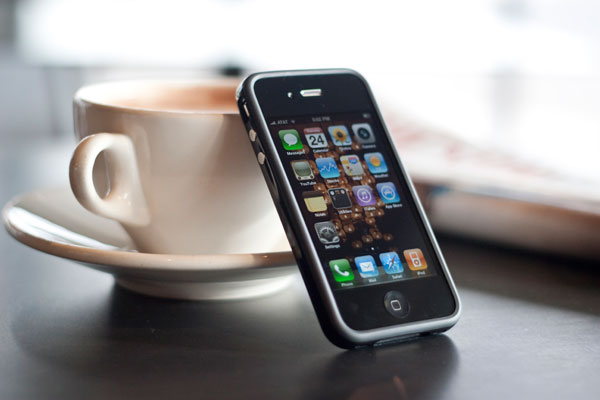
Apple's iPhone 4 with Bumper Case
It's a self fulfilling prophecy. Steve gets up on stage, proclaims the iPhone 4 to be the biggest introduction since the original iPhone, and the public flocks to Apple stores to fork over $200 on day one and around $2500 over the course of two years for the privilege. But this isn't 2007. Apple has real competitors in the smartphone space. Android phones have grown in features, polish and popularity. Even Palm entered the race with a competant offering, and Microsoft isn't far behind. It's easy to start a revolution when everyone else is doing the wrong thing, but what about when more companies actually get it? Was Steve justified in his excitement over the 4? That's what we're here to find out today.
Straight on it looks like just another iPhone. You get the black face with a shiny trim. From the side it is the redesign that Apple has needed for a while now. It’s not revolutionary but it’s the type of improvement that makes its predecessor feel old. And that’s exactly what this does. Have a look for yourself:
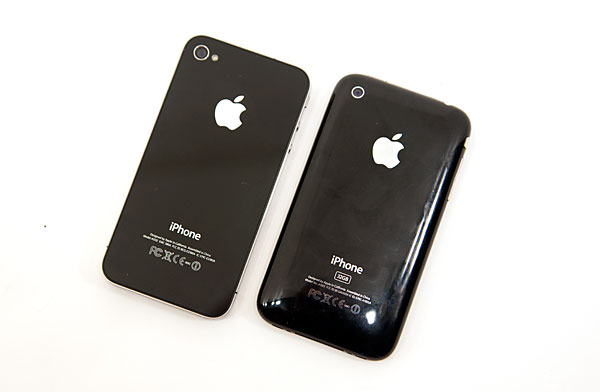
iPhone 4 (left) vs. iPhone 3GS (right)
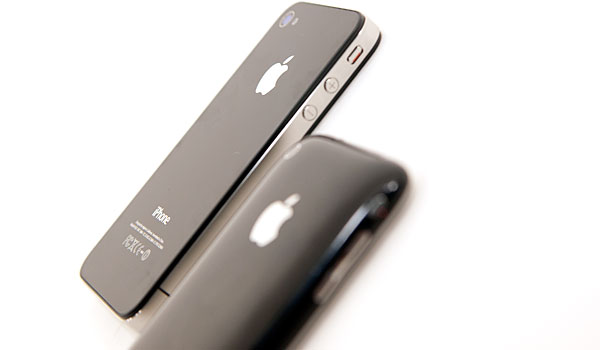
The straight lines, smaller dimensions and lack of unnecessary bulk make the 3GS feel like a car from the 90s, unnecessarily curvy. The styling is now so much more compact. Compared to the iPhone 3GS the 4 is around 5% narrower (but no more difficult to type on) and nearly 25% thinner. It even makes the Nexus One look dated:
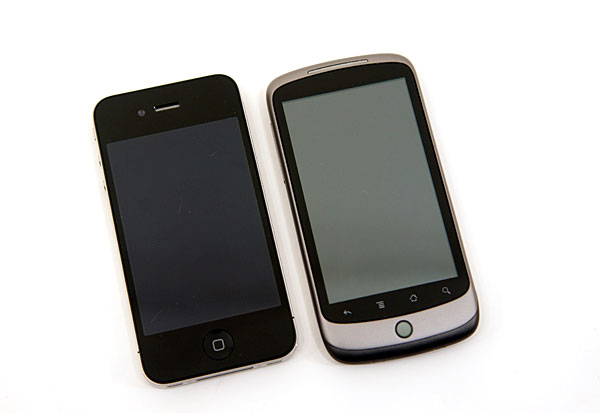
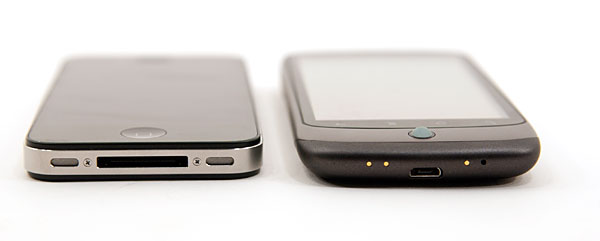
The iPhone 4 is slightly heavier than the 3GS (4.8oz vs. 4.7oz). You feel the added weight but I wouldn't call it heavy. The front and the back of the iPhone 4 are both made out of glass, and they protrude beyond the stainless steel band that wraps around the phone (more on this controversial decision later). While this gives the 4 an amazing finish, it also makes carrying the phone nerve racking. Coupled with the smaller, more dense form factor I’m now deathly afraid of dropping and shattering this thing. Apple has done a lot to reinforce the glass, however there have been enough reports already of shattered iPhone 4s for me not to feel very safe. Only Apple would think to make the two surfaces most likely to hit something out of glass. It's like making mouse traps out of cheese, something bad is bound to happen.

iPhone 4 (left) vs. iPhone 3GS (right)
The physical buttons (but not their layout) have changed on the 4. The ringer switch has shorter travel and feels sturdier as a result. The volume rocker has been replaced by discrete volume up/down buttons, also very sturdy in feel. The power/lock button is also now made out of stainless steel. Only the home button remains unchanged, although it does seem to make a deeper click when you use it.

The speaker moved to behind the right grill at the bottom of the phone instead of the left. The dock connector thankfully remained unchanged. It looks like Apple is committed to maintaining this connector until it makes the jump to something wireless (or optical?).

The back of the phone is pretty. Apple broke with tradition and finally included a single LED flash on the phone. The flash comes on in low light conditions and is enough to take shots in total darkness.
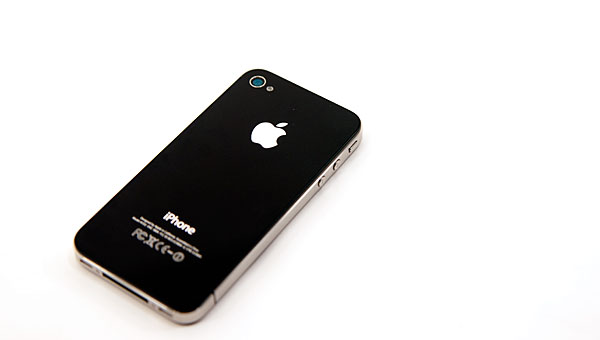
The camera has been upgraded to a low noise 5MP sensor. It can shoot stills at up to 2592 x 1936 or video at 1280 x 720 @ 30 fps. We’ll go into greater detail on its quality in the camera section. The iPhone 4 also adds a front facing camera capable of shooting both photos and video at 640 x 480.
Apple quotes contrast ratio as 1000:1, in our measurements we got very close (952:1). A significant improvement over the 188:1 ratio of the 3GS. Apple achieved this by both dropping black levels and increasing the white levels on the display. Improving both is always fine by me.
Internally the iPhone 4 uses Apple's new A4 SoC, built around an ARM Cortex A8 CPU and a PowerVR SGX GPU. The new SoC is built on a 45nm process and features 512MB of memory on the package. Apple hasn't made CPU clock speed public, but I'm guessing around 800MHz compared to the iPad's 1GHz for reasons you'll see later. GPU clock speed is unknown as well. Having more memory on package is an interesting move by Apple as it makes the iPhone 4 better suited for multitasking compared to the iPad. Also implying that shortly after the iPad gets multitasking it'll be updated to a version with more memory as well.
The iPhone now has an gyroscope as well the rotation sensors of its predecessors. Developers are given full access to the gyroscope making the iPhone 4 capable of becoming a very expensive Wii-mote.
| Physical Comparison | ||||||||
| Apple iPhone 4 | Apple iPhone 3GS | HTC EVO 4G (Qualcomm Snapdragon QSD8650) | HTC Droid Incredible (Qualcomm Snapdragon QSD8650) | Google Nexus One (Qualcomm Snapdragon QSD8250) | ||||
| Height | 115.2 mm (4.5") | 115 mm (4.5") | 121.9 mm (4.8") | 117.5 mm (4.63") | 119 mm (4.7") | |||
| Width | 58.6 mm (2.31") | 62.1 mm (2.44") | 66.0 mm (2.6") | 58.5 mm (2.30") | 59.8 mm (2.35") | |||
| Depth | 9.3 mm ( 0.37") | 12.3 mm (0.48") | 12.7 mm (0.5") | 11.9 mm (0.47") | 11.5 mm (0.45") | |||
| Weight | 137 g (4.8 oz) | 133 g (4.7 oz) | 170 g (6.0 oz) | 130 g (4.6 oz) | 130 g (4.6 oz) | |||
| CPU | Apple A4 @ ~800MHz | Apple/Samsung A3 @ 600MHz | Qualcomm Scorpion @ 1GHz | Qualcomm Scorpion @ 1GHz | Qualcomm Scorpion @ 1GHz | |||
| GPU | PowerVR SGX 535 | PowerVR SGX 535 | Adreno 200 | Adreno 200 | Adreno 200 | |||
| RAM | 512MB LPDDR1 (?) | 256MB LPDDR1 | 512MB LPDDR1 | 512MB LPDDR1 | 512MB LPDDR1 | |||
| NAND | 16GB or 32GB integrated | 16 or 32GB integrated | 8GB micro SD | 8GB micro SD | micro SD | |||
| Camera | 5MP with LED Flash + Front Facing Camera | 3MP | 8MP with dual LED Flash + Front Facing Camera | 8MP with LED Flash | 5MP with LED Flash | |||
| Screen | 3.5" 640 x 960 LED backlit LCD | 3.5" 320 x 480 | 4.3" 480 x 800 | 3.7" 480 x 800 AMOLED | 3.7" 480 x 800 AMOLED | |||
| Battery | Integrated 5.254Whr | Integrated 4.51Whr | Removable 5.5Whr | Removable 4.81 Whr | Removable 5.18 Whr | |||
The iPhone 4's logic board shrinks in size thanks to further component integration, making room for a much larger battery. The 5.25Whr battery in the iPhone 4 is a 16% increase from what was in the 3GS, and 95% of what HTC put in the EVO 4G. While raw performance improved, it's clear that Apple's focus this time around was battery life. Again, we'll dive into specifics later in the review.
Moving back outside Apple surrounded the phone with a stainless steel band. This band doubles as the 3G, WiFi and Bluetooth antennas. And if you hadn't noticed, it also moonlights as a giant elephant. Let's talk about it.










270 Comments
View All Comments
Lemurion - Friday, July 2, 2010 - link
I was disappointed that you they only compared the iPhone 4 screen to the 800 by 480 AMOLED screens on some of the Android devices. As far as I know, all those devices use the Pentile system, which reduces the crispness of text.I would have really liked to compare the new Apple screen to the Motorola Droid's 266 PPI screen and see how noticeable the difference there was.
Matt Campbell - Friday, July 2, 2010 - link
Nice investigation work on the signal strength. Just wanted to point out that AnandTech is cited in the Apple iPhone 4 software fix story on CNN today. http://www.cnn.com/2010/TECH/mobile/07/02/apple.ip...Bad Bimr - Friday, July 2, 2010 - link
http://www.cnn DOT com/2010/TECH/mobile/07/02/apple.iphone.apology/index.htmlJust like apple, finally admitting a problem, pleasing the fan boys by saying it will be addressed and doing nothing to fix it. I am so glad I never jumped on the apple bandwagon.
fischerm83 - Friday, July 2, 2010 - link
So i was reading various news articles today and saw that apple finally figured out/admitted to what you guys found out earlier this week...*quote*
Now the company says its engineers have made a "stunning" discovery. Reception is poor and calls may be dropped because not only are people holding the phone wrong, but they also think they have a better signal than they do. In the statement, Apple says that it has made a mistake in the formula that calculates the number of bars that display the signal strength on all of its iPhones.
"We were stunned to find that the formula we use to calculate how many bars of signal strength to display is totally wrong," it said in a statement.
*quote*
Full Article:
http://news.cnet.com/8301-30686_3-20009564-266.htm...
Nice work guys, keep up the amazing work!
anandreader - Friday, July 2, 2010 - link
Brian-I'm confused as to what had to happen to get Fieldtest onto the iphone 4. Understood the bit about jailbreaking the iphone3 but didn't understand how that information got transfered to the 4.
Could you elaborate a bit there?
Per Grenerfors - Friday, July 2, 2010 - link
Thanks for the great review, AnandTech.In countries where 3G coverages isn't spotty like a teenagers face, the whole antenna/at&t/verizon debate is just utterly unnecessary.
Apple is the only brand name in tech today that's recognized by the broader public. Their products therefore make a big splash in the media when they hit the market. But the bigger splash you make, the more mud comes floating up from the bottom. Like people complaining with a spec sheet in hand without ever having seen the device in real life. Or just plain old haters. This is the downside to fame. But I'm sure Apple's laughing all the way to the bank.
Stokestack - Friday, July 2, 2010 - link
A case isn't an acceptable workaround for this. I don't buy a thin phone to bulk it up and junk it up with a cheesy case or add-on of any kind.While I'm not planning on getting an iPhone 4, if I had one and wanted to keep it I'd try to spray a coating onto the antenna band. I'd mask the front & back, the buttons, and any seams, then spray with polyurethane or something. While it would be microscopically thin, there's be no direct contact with skin. And really, that's what you said you expected Apple to have done anyway. Let's see if it would work.
Excellent review. The hack to get the numeric signal strength rocks.
Fulle - Friday, July 2, 2010 - link
Thank you for the review. It was useful to be able to look at something that was detailed, and included facts, good and bad, without a ridiculous amount of bias. It's obvious that Anand likes, or at least really wants to like most Apple products, but it was nice that that didn't get in the way of the review.The new iPhone seems to be an OK device that's on par with new Android smartphones in way of hardware... The screen's got 20% higher pixel density than the Droid, but 50% worse contrast ratio, and worse black quality... Java performance is clearly inferior to a Nexus One, but browsing performance is competitive (I'd say good, but I think all handsets have shit browser performance). Its sleak and thin, but it has no hardware qwerty. The 5MP camera produces low noise, but, the white balance is messed up, making it overall inferior to the camera in a Nexus One or HTC Incredible (or Moto Droid, even, IMHO... screwed up over-saturated colors with bad white balance are a big deal to me). Overall, it's an average device when put up against worthy competition (EVO4G, DroidX, HTC Incredible, Nexus One, or even a Moto Droid).
But, that's before you have to deal with the obvious design flaws. Glass panels on both sides? WTF? Uninsulated external antenna? These aren't minor flaws here.
So, overall I'd say that the new iPhone is inferior to at least 6 Android smartphones.... and at first I grin at that... but then I'm disappointed and mad. Apple has helped make the smartphone market the competitive environment it is today, and when they drop the ball like this, it means that other venders don't have to raise the quality of their devices to compete. It's just fortunate that Android has so many hardware OEMs, like HTC, Samsung, and Motorolla, all competing with each other... or else I'd be afraid the only thing the iPhone4 would push in competition is a higher ppi on the screens.
Lets hope this helps push the Cortex-A9 equipped Android's this winter to include higher resolution in their displays... but, man, I'm disappointed with this device.
tgibbs - Friday, July 2, 2010 - link
Does zero dB represent a standard absolute signal strength or is it an arbitrary reference value that will differ for different phones?navderek - Saturday, July 3, 2010 - link
The signal is actually measured in dBm which means it is a reference to 1mW of power.For example -30dBm = 1000 times less that 1mW = 1uW
1 microwatt does not seem like much, but actually this is a very strong signal for the mobile and you would rarely have that much power arriving at your handset from the tower. In good conditions, close to the tower or serving antenna with minimal obstructions you could expect about -50 to -60 dBm (-60dBm = 1nW (nanowatt). The system is designed to deal with such small signals...this is why I laugh when people are worried about cell tower "radiation" when actually 5 min. in the sun is a bazzillion times more radiation than what's coming out of a tower....cellular towers that is, broadcast radio towers or paging systems are another story!
But I digress...to answer your question simply, zero dBm simple equals 1mW.
Zero dBm signifies that there is no difference in ratio from the reference of 1mW.